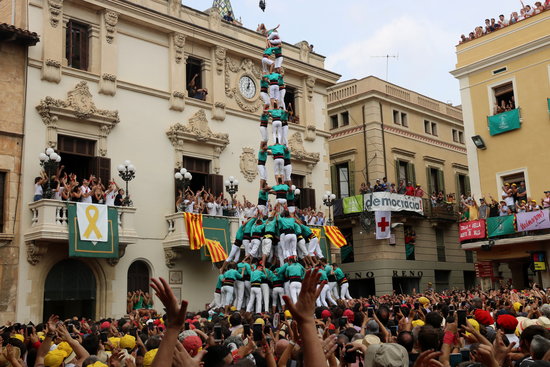All set for quintessential human towers festival
Vilafranca del Penedès hosts one of the season’s top events with four of the best groups

In Penedès, arguably the heart of one of Catalonia’s finest wine-growing regions, and where cava is not only a festive drink but a highly profitable business, another quintessentially Catalan tradition runs strong: human towers.
In Vilafranca, one of the region’s biggest towns, this tradition is lived out at least once a year and is followed with as much expectation as the most crucial of football matches. And the 2019 date has come.
Sant Fèlix (Saint Felix), celebrated on August 30, is honored with a human tower building session. They are made by large groups of people known as ‘colles’ that form tiers of differing sizes, with those above balancing on the shoulders of those below. There are typically one or two ‘colles’ per town present at the event.
Traditionally, and this year will be no exception, four ‘colles’ will be meeting at Vilafranca’s central square, Plaça de la Vila. This edition will see the local group, Castellers de Vilafranca, alongside the Colla Vella dels Xiquets de Valls, the Colla Jove dels Xiquets de Valls and the Colla Joves Xiquets de Tarragona – that is, Catalonia’s four best ‘colles’ according to Tarragona’s biannual competition.
Hours before the session starts at 12:15 pm, the square will already be crowded, with the surrounding houses’ balconies offering privileged views.
According to the specialized media outlet elmoncasteller.cat, spectators can expect up to 10-tier tall human towers, which is the highest number seen in this tradition.
More than one of the groups may try to build such a tower, with three to four people per floor, or others such as the 8-tier tall towers with one person per floor.
What are human towers
Declared Masterpieces of the Oral and Intangible Heritage of Humanity by UNESCO in 2010, Catalonia's human towers -or 'castells'- are one of the country's most unique customs.
The tradition first documented in the 17th century sees large groups -known as 'colles'- forming tiers of differing numbers of people standing on the shoulders of those below them.
A human tower is only complete once a child called the 'enxaneta', who can be as young as five, clambers to the very top of the structure and raises their arm.
The towers are a common -and breathtaking- sight in towns squares all over the country, where they are built during local festivals to the sound of traditional 'gralla' flutes and drums.
'Castells' will often come crashing down, although the 'castellers' have their own human safety net in the dozens of team members supporting the tower's base, or 'pinya'.
There are 'colles' in towns and cities all over Catalonia that spend months practising at building the tallest and most complex human constructions.
Each 'colla' is distinguished by the color of its shirts, and 'castellers' wear traditional garb of white trousers and a wide black sash around the waist, providing back support and a foothold to help team members climb up or down the tower of people.